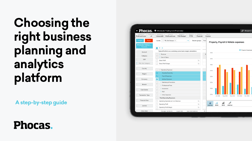How to overcome reporting challenges in your business

The ability to access relevant and timely information is critical for business people to make fast and accurate decisions and move forward. However, as many managers know, traditional (static) management reporting processes have a range of shortcomings. In this blog we will discuss a few key solutions to the challenges of static reporting.
Challenge: Reporting is time consuming
Many CFOs are all too familiar with the long, and often frustrating, wait for IT or their own finance team to build and return financial reports. If additional information is needed, the request for extra or custom reports can further delay decision making. Stakeholders need actual data at their fingertips and weekly, monthly, and annual reports are no longer viable to make critical business decisions.
On the flipside, extra reporting is often the last thing your IT and finance teams want to spend time on. These people manage a myriad of competing priorities and many ERPs are slow at generating reports once the query has been entered.
Solution: Give data-access to end-users
By implementing a self service reporting and business planning and analytics platform, reporting wait times are eliminated. This is because platforms like Phocas access up-to-date business intelligence data and present it back to you in a user-friendly format. Executives and managers can designate a schedule for the generation of standard reports or favourites to be automated and sent directly to inboxes or saved on home pages. For instance, you can schedule a weekly report to be generated for your staff meetings. However, if you are in a meeting and find you need to edit reports to include more information, self-service functionality makes this as easy as a couple of button clicks. Phocas allows managers to interrogate the financial statements like the Balance Sheet and Profit and Loss Statement at any time throughout the month and determine what is causing the increase or decrease to margins or customer profitability.
Challenge: Reporting does not give me the level of detail required
Many static reports provide a summary of information without much detail yet when a metric reveals an abnormality, the detail is crucial. This requires a new, custom report to identify the underlying data driving the change.
Another drawback to static reporting is the potential for missed opportunities. Static reports create a bias of only looking at information you request but when reports are linked to consolidated and up-to-date data you can explore other hypotheses. For instance, your sales manager may request a breakdown of sales revenue by region. The sales figures may appear to be on target. Yet, a detailed or dynamic report might show a different story - that while overall sales are on target, one over-performing product is actually masking the declining sales of another product type. With this information, your sales manager can intervene to boost the sales of the underperforming product, thereby increasing sales revenue overall.
Solution: Dynamic reporting
The dynamic reporting available within a business planning and data analytics platform allows everyone to click on a metric and drill down into the underlying data. Anyone in the business can ask questions and follow their train of thought to discover answers. For instance, you may discover that your sales team is not going to meet expected forecasts for the month. You can drill down to view sales by product group, region, sales rep, and more, so you can quickly identify and address the contributing factors.
Challenge: I have to manipulate and combine reports in spreadsheets
Companies often store data in multiple systems such as CRMs and ERPs. Each system can be complex, but hard to extract data from; a data silo. After reports are created from each source, this data needs to be combined so it can be accessed from a single source, typically an excel spreadsheet. While spreadsheets have their uses in business, they are an inefficient option for reporting. If the data is coming from multiple sources, how is it being kept in sync? What controls are in place to reconcile the data back to the source? A mistake in a single cell will be carried throughout and invalidate the entire report. Additionally, when a spreadsheet is being shared, it is difficult to guarantee that everyone is using the most current version.
Solution: A system that integrates data from multiple sources
A business planning and analytics platform provides a single source of truth by consolidating data from your ERP and other business systems. Phocas is designed to integrate seamlessly to your various data sources and funnel this disparate data into one place. Data collection and data management is automated, meaning data quality is assured. Your near real-time data is accessible to track KPIs, create dashboards, forecast and re-forecast without fear of accidentally altering or deleting key data.
Challenge: I have to be at the office when I’m creating reports
Business people who travel between locations or have hybrid workplaces need the flexibility to access their data anywhere. When a manager is tethered to their office, their efficiency and effectiveness may be seriously impacted.
Solution: Mobile cloud data access
Business Planning and Analytics platforms provide cloud access to your data in the office, at home or on the road. This enables you to explore your data and create dynamic reports wherever you are. Present charts and reports to your customers or with your purchasing manager on the warehouse floor. Data accessibility enables you to make decisions and offer a quick response.
Challenge: My team does not know how the business is performing
Firstly, it is difficult for employees to understand financial information if the report is a wall of numbers or they have never been taught how the numbers relate to their job roles. This may lead them to feel they are shooting in the dark. Secondly, when performance is not shared with your workforce they don’t have personal accountability or clear direction. Without this sense of trust, employees may not have the confidence to independently act on the information.
Solution: Give employees (restricted) access to data
To encourage your team, provide them with access to the data that is critical to their role. When your employees can independently query the data and gain insights relevant to their position or branch, they become more autonomous, take more ownership, and begin going to their managers with solutions rather than problems. However, since employees don’t need full access to all company data, business planning and analytics platforms are designed to manage the flow and access to data with ease. Manage access by setting user restrictions and allowing finance administrators to share reports as dashboards or add specific sections to customized profit and loss (income statements). Give Your sales team may have access to the sales data they need and not the salaries of their colleagues.
Phocas can help overcome your reporting challenges
A business planning and analytics platform like Phocas can help overcome many reporting challenges in your business. Alerts built into the reporting system can let your team know the moment performance starts to drift off course. Self service functionality lets your team move on from templated reports and adapt quickly when reporting requirements change. Integrations with multiple different business data systems automate the collation and generation of financial and operational reports that you know are accurate and up-to-date.
Find out how Phocas can help solve your reporting challenges with a free demo today. Or learn more about what you need to consider when selecting a business planning and analytics system for your business with our ebook.

Empowering businesses with intuitive data analytics, driving informed decisions for growth and profitability. We make people feel good about data.

How technology is fixing the finance talent shortage and bringing a renaissance
Accounting is one of the oldest professions, with double-entry bookkeeping tracing back to Roman merchants in the 14th century. And the genius of a system in which every transaction is recorded with an opposite entry in a different account continues to be standard practice. Just as accounting emerged during the shift from the Middle Ages to the Renaissance, today’s finance teams must also adapt to new challenges and opportunities.
Read more
Using data to plan for the impact of tariffs and further change
Tariffs are here. Whether you're in manufacturing, distribution or retail, it's important to understand how importing from affected countries such as Canada, Mexico or China or chosing local production, can affect your bottom line. We want to encourage you to scenario plan now not retrospectively.
Read more
5 key FP&A trends for 2025
The role of the CFO is evolving rapidly, extending beyond traditional financial stewardship to encompass business partnering, operational oversight and technological innovation. A 2024 Sage study of over 1,200 global finance leaders reinforces this transformation:
Read more
Are you ready for decision intelligence?
What are your best business decisions? And your worst? Reflecting on these choices, you’ll likely notice a pattern. The best decisions were informed by reliable data, while the worst were made with incomplete or misleading information. Fast and specific business decisions increasingly depend on data. But while data is critical, the human element remains strong. Decision-making requires the right mix of accurate information and human experience, so how does decision intelligence (DI) enhance the decision-making process?
Read more
Find out how our platform gives you the visibility you need to get more done.
Get your demo today